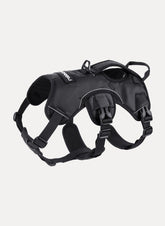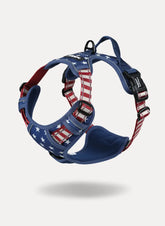How to Put on Rabbitgoo Dog Harness?
Let us guess - you've just bought one of our Rabbitgoo dog harness, and you're wondering how to get it on them, right? Don't worry, we get it. This can be a bit tricky, especially if you're new to using a harness.
That's exactly why we've put together this step-by-step guide. We'll cover everything you need to know about how to put on a Rabbitgoo dog harness, including whether all our harnesses (even the no-pull ones) work the same way.
Just keep scrolling and we'll walk you through the whole process. We've got answers to all your harness questions coming right up!
|
Key-Takeaways: How to Put On Rabbitgoo Dog Harness? |
|
● Choose the right harness: Inspect the harness to ensure it's the correct size for your dog. If it’s the wrong size, buy the right size of harness. ● Introduce the harness to your dog: Choose a calm, quiet environment to introduce and put on the harness. This helps reduce stress for your dog. ● Put on the harness: Gently place the harness on your dog, following the correct method for your harness type. Secure all buckles and adjust the straps for fitting (but comfortable fit). You should be able to fit two fingers between the harness and your dog's body. |
Step-by-Step Guide to Putting on Rabbitgoo Dog Harness
Here’s the step-by-step guide to putting on all Rabbitgoo dog harnesses. Make sure to carefully follow the steps for a comfortable and safe fit for your dog.
Step No# 1 - Inspect Your New Harness
The first and most important step is to inspect the harness. Although we’re sure you’ll find no problem with our Rabbitgoo harnesses because we ensure our customers get the quality products they’ve seen in the picture, it’s better to check for the size.
Sometimes (especially if you’re buying the harness for the first time) we make mistakes by choosing the wrong type or size harness. If that’s the case, our suggestion would be to buy the right size of harness.
Loose or tight, both situations can be dangerous and uncomfortable for the dog. They may develop a fear of the harness and will run whenever you try to put it on.
Step No# 2 - Understand How Harness Works
Now, take a good look at your Rabbitgoo dog harness. You'll notice it has two main parts: a loop for the neck and straps for the chest. You'll have to slip that neck loop over your dog's head first.
Afterward, you have to adjust the straps and buckle up the harness from the side. This process is the same for most harnesses, however, if you’ve stepped in a harness things will be a bit different.
For example, in a step-in harness, you’ve to place the paws of your dog inside the two loops, not the neck. So, you need to learn specifically how to put on the harness according to the type.
Step No#3 - Get Your Dog Ready in a Calm Environment
Since you have an idea about how the harness works, now make sure to get your dog ready in a calm environment.
Find a nice, quiet spot where your dog feels comfy. Choose their favorite room, or somewhere they like to chill. Trust us, a calm dog makes this whole process way easier.
Keep in mind, never force them to put the harness on as it will make the situation worse. First, make sure they’re comfortable with the harness, then put it on. Also, don’t forget to show love with your dog's favorite treat.
Step No#4 - Secure the Harness Snugly Around Your Dog’s Chest
Once your dog is in a calm and comfortable environment, place the harness over your dog's head. First, let the harness go through the neck and then the chest. This process might be different depending on the type of harness you’ve.
After putting the harness on, secure it carefully. You’ve to adjust the straps for a perfect fit. If you want to loosen the harness around the dog's body, tighten the straps and buckle it. In contrast, if the harness is too tight, you’ve to loosen the straps for the fitting.
Step No#5 - Double-Check for Comfort: Is Your Dog Ready to Go?
Last but the most important point, always double-check for the comfort of your dog. Dogs can’t talk like us and say they’re uncomfortable, we’ve to check their expressions and body language.
Let your dog run freely in the home after putting on the harness. Check how they’re reacting, whether they’re running, walking comfortably, or they’re trying to get off the harness. If they’re not walking and all attention is on getting off the harness, it might be because the harness is uncomfortable.
Make sure the harness isn’t too tight and is loose enough for you to add two fingers. Remember, only two fingers together. If you’re able to add more than two fingers, like three or four, the harness is too loose.
Final Thoughts: Putting on Rabbitgoo Dog Harness
A harness is no doubt important to ensure the safety of dogs outside of the home. However, what’s more important is ensuring it fits comfortably and correctly. Remember, patience is key when introducing a new harness. Take your time, use plenty of treats, and make it a positive experience for your friend.
FAQs
How do you put a harness on a difficult dog?
If your dog is difficult when it comes to putting on a harness, it must be because they relate the harness to an unpleasant experience. So, you need to introduce the harness again but positively and gently.
- Start by letting your dog see and sniff the harness. Leave it near their favorite spot to make it a normal part of their environment. Reward your dog with treats and praise whenever they show interest in the harness.
- Once they’re comfortable around the harness, try to put it on, and reward them. Be patient and don’t rush the process. Every dog is different, and it might take some time for them to feel comfortable.
Why does my dog hate her harness so much?
There could be a few reasons - maybe it's uncomfortable, doesn't fit right, or your dog associates it with something unpleasant. Try introducing it gradually with treats. Check the fit carefully. If nothing helps, you might need to try a different style.
Is it OK for a dog to wear a harness all the time?
Nope! Dogs need some harness-free time to let their skin breathe. Take it off when you're at home or your dog is resting, and always check for any signs of irritation.








